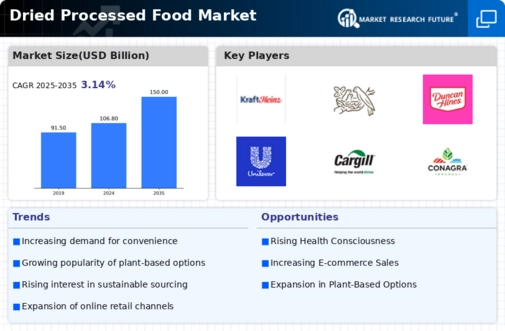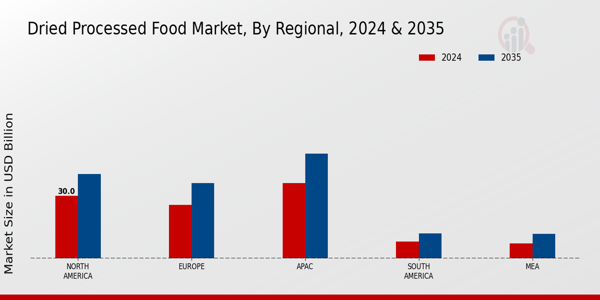E-Commerce Growth
The Dried Processed Food Market is witnessing a substantial transformation driven by the growth of e-commerce. As online shopping becomes increasingly prevalent, consumers are turning to digital platforms for their grocery needs, including dried processed foods. Recent data indicates that online sales of dried fruits and snacks have surged, with e-commerce channels accounting for nearly 20% of total sales in this sector. This shift is attributed to the convenience and variety offered by online retailers, allowing consumers to access a broader range of products than traditional brick-and-mortar stores. Additionally, the rise of subscription services and direct-to-consumer models is reshaping purchasing behaviors, further propelling the Dried Processed Food Market into a new era of accessibility and consumer engagement.
Health-Conscious Choices
The Dried Processed Food Market is experiencing a notable shift towards health-conscious choices among consumers. As individuals increasingly prioritize nutrition, the demand for dried fruits, vegetables, and legumes has surged. This trend is reflected in the market data, which indicates that the dried fruit segment alone is projected to grow at a compound annual growth rate (CAGR) of approximately 5.5% over the next five years. Consumers are gravitating towards products that offer convenience without compromising on health benefits. The rise of plant-based diets and the emphasis on natural ingredients further bolster this driver, as dried processed foods often align with these dietary preferences. Consequently, manufacturers are innovating to create healthier options, thereby enhancing their market presence in the Dried Processed Food Market.
Sustainability Initiatives
Sustainability initiatives are becoming increasingly pivotal within the Dried Processed Food Market. As environmental concerns gain traction, consumers are more inclined to support brands that prioritize sustainable sourcing and production practices. This shift is evidenced by a growing number of companies adopting eco-friendly packaging and reducing food waste through innovative drying techniques. Market data suggests that products labeled as organic or sustainably sourced are witnessing a significant uptick in sales, with some segments reporting growth rates exceeding 7% annually. This trend not only reflects consumer preferences but also encourages manufacturers to invest in sustainable practices, thereby enhancing their competitive edge. The Dried Processed Food Market is thus evolving to meet these expectations, fostering a more environmentally responsible approach to food production.
Culinary Trends and Innovations
Culinary trends and innovations are significantly influencing the Dried Processed Food Market. As consumers become more adventurous in their culinary pursuits, there is a growing interest in unique flavors and exotic ingredients. This trend is prompting manufacturers to experiment with new drying techniques and flavor profiles, thereby expanding their product offerings. Market data suggests that the introduction of innovative products, such as spiced dried vegetables and fruit blends, is attracting a diverse consumer base. Furthermore, the rise of cooking shows and social media platforms has heightened awareness and interest in dried processed foods, encouraging consumers to incorporate these items into their meals. As a result, the Dried Processed Food Market is likely to continue evolving, driven by the demand for novel and exciting culinary experiences.
Convenience and On-the-Go Consumption
Convenience and on-the-go consumption are emerging as critical drivers within the Dried Processed Food Market. As lifestyles become increasingly fast-paced, consumers are seeking quick and easy meal solutions that do not compromise on nutrition. Dried processed foods, such as ready-to-eat snacks and meal kits, cater to this demand by offering portability and extended shelf life. Recent market analysis indicates that the convenience food segment is projected to grow at a CAGR of around 4% over the next few years. This trend is particularly pronounced among busy professionals and health-conscious individuals who prioritize both convenience and quality. Consequently, manufacturers are focusing on developing products that align with these consumer preferences, thereby enhancing their market share in the Dried Processed Food Market.


















Leave a Comment